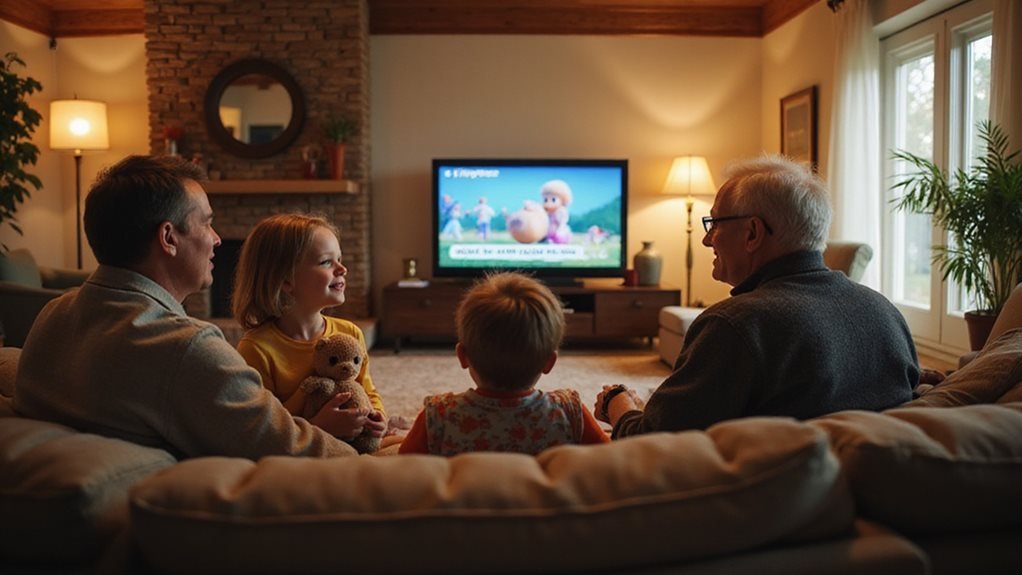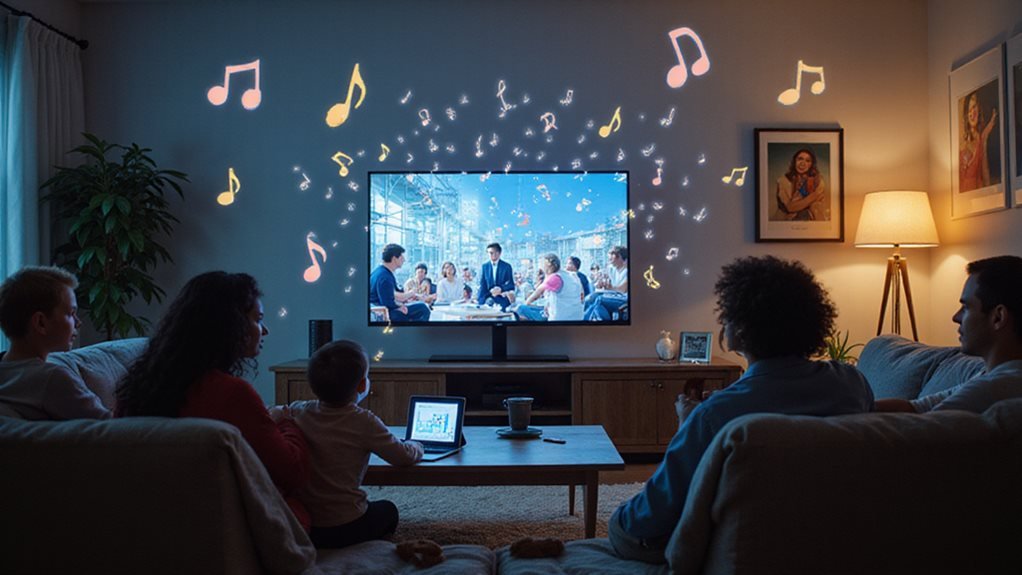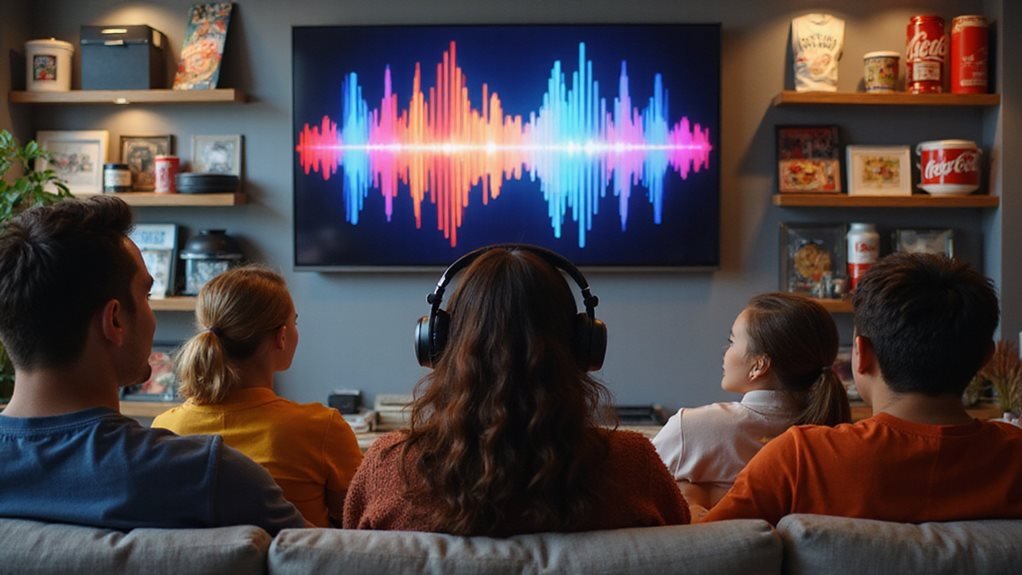TV jingles have proven instrumental in shaping brand recognition, with studies demonstrating their critical role in improving recall and differentiation. By combining music and messaging, jingles serve as auditory signatures, leaving a lasting impression on consumers. Approximately 74% of people can identify a brand solely through its jingle, underscoring its potency. This fascinating intersection between melody and marketing invites deeper exploration into how jingles create sentimental connections and elevate brand identity.
Key Takeaways
- TV jingles increase brand recognition by 43% when adapted to contemporary themes.
- Familiar jingles trigger nostalgia, enhancing brand affinity and consumer loyalty.
- Melodic jingles activate emotional arousal, boosting retention and recall efficiency.
- Distinctive jingles enhance brand recall by approximately 30%, thereby fostering brand differentiation.
- Cohesive auditory branding across platforms enhances brand presence in the digital landscape.
The Evolution of Jingles in Advertising
Over the decades, advertising jingles have undergone significant transformation, reflecting broader trends in marketing strategies and consumer behavior. The impact of jingles on branding cannot be overstated. Initially, jingles were simple, catchy tunes, tailored to instill brand recall among listeners. Metrics have shown their effectiveness in enhancing brand retention, ultimately fostering a sense of belonging among consumers. As digital media emerged, jingles evolved into more sophisticated auditory logos, strategically aligned with brand identity and values. By analyzing data, one can observe that these changes were driven by the need to adapt to increasingly fragmented markets. Today, the impact of jingles on branding persists, as they continue to serve as pivotal tools, anchoring the brand image in consumers’ auditory experiences.
How Jingles Create Emotional Connections

Research consistently shows that TV jingles can serve as powerful triggers of sentimental memory, influencing consumer behavior by associating brands with positive feelings and experiences. Studies indicate that nostalgia induced by familiar jingles often improves brand loyalty, as people are likely to form enduring attachments to brands that evoke a sense of comfort or familiarity. Moreover, the psychological impact of music in jingles can influence mood and recall, potentially increasing the likelihood that consumers will make decisions in favor of the advertised products.
Emotional Memory Triggers
When crafting a memorable brand experience, the power of TV jingles in creating sincere connections cannot be underestimated. Jingles serve as sentimental memory triggers that encode feelings into lasting auditory imprints. Research indicates that emotionally charged jingles enhance brand recognition by activating the brain’s associative networks, which link melodies to individual experiences. This subconscious process strengthens consumer-brand ties, fostering a sense of belonging.
| Emotion Type | Brand Connection Impact |
|---|---|
| Joy | Boosts recall |
| Trust | Builds loyalty |
| Surprise | Increases engagement |
| Sadness | Deepens connection |
| Anticipation | Drives curiosity |
The interplay of emotion and memory positions jingles as powerful marketing tools. By utilizing specific emotions, brands can effectively influence consumer perceptions, ensuring they remain top of mind in competitive markets.
Nostalgia and Brand Loyalty
In the realm of brand messaging, the nostalgic quality of TV jingles plays a crucial role in fostering brand loyalty. Psychological evidence suggests that nostalgia, a sentimental longing for the past, fosters heartfelt connections. Jingles often tap into listeners’ shared memories, creating a sense of community and belonging. Consequently, when people encounter these jingles, they are transported back to moments they hold dear, effectively enhancing brand affinity. Studies show that jingles leveraging nostalgia effectively imprint brand identity onto the consumer’s mind, resulting in heightened recognition and loyalty. By revisiting auditory elements from bygone eras, advertisers can cultivate enduring connections between consumers and brands. Therefore, nostalgia functions not merely as a marketing tool but as a core component of consumer-brand relationships.
Music’s Psychological Impact
Although often overlooked, the psychological mechanisms underlying music’s impact reveal why TV jingles are so effective in evoking emotional connections with an audience. Research highlights that music engages the brain’s limbic system, which is primarily responsible for processing emotions. This becomes critically significant in establishing meaningful associations between a brand and its consumers. Jingles, through melody and rhythm, stimulate emotional arousal, leading to increased retention and recall of brand messages. Studies indicate that 74% of consumers can correctly identify a brand solely based on its jingle. By creating a shared auditory experience, these jingles foster a collective sense of belonging among audiences. Consequently, the strategic use of music in advertising not only improves brand recognition but also strengthens the emotional bond with its audience.
The Science Behind Jingle Recall

Research indicates that jingle recall is considerably influenced by factors such as memory and musical catchiness, with catchy tunes enhancing retention and brand association. This phenomenon can be attributed to the activation of neural pathways, where auditory stimuli linked to jingles strengthen connections in the brain. Additionally, jingles trigger sentimental responses that not only improve recall but also foster a stronger bond with the brand.
Memory and Musical Catchiness
Embedded within the structure of memorable TV jingles lies a fascinating interplay between cognitive science and musical elements, forming a critical basis for brand recall. Musical catchiness utilizes several key components to improve memory retention and recognition. These elements act in concert to ensure that jingles are not only heard but also remembered.
- Repetition: Research indicates that the repetition of musical and lyrical phrases helps embed the jingle in long-term memory.
- Melodic Contour: Catchy tunes often use predictable patterns and intervals, which align with cognitive preferences for familiar and pleasing sequences.
- Emotional Resonance: Songs that evoke emotions can further cement brand associations through effective recall pathways.
This precise combination fosters a shared cultural framework where brand identities thrive, becoming integral to consumer identities.
Neural Pathways Activation
The intricate mechanisms of how TV jingles affect memory find resonance in the activation of neural pathways, providing an analytical basis for understanding jingle recall. Neuroimaging studies have revealed that auditory stimuli from jingles activate specific brain regions associated with auditory perception and memory storage. This activation facilitates the formation of synaptic connections, leading to enhanced encoding and retrieval processes. Jingles, due to their repetitive structures and rhythmic patterns, reinforce these neural pathways, allowing for more durable memory traces. Moreover, dopamine release, prompted by the pleasure derived from familiar tunes, strengthens these connections, contributing to the long-term retention of jingles. Engaging multiple sensory pathways through jingles yields a multifaceted cognitive experience, reinforcing people’s connections to brands and fostering a sense of community among those who share these auditory cues.
Emotional Response Triggers
When examining the science behind jingle recall, sentimental response triggers reveal significant insights into the effectiveness of this phenomenon. Affective connections play a pivotal role in reinforcing brand recognition. Studies indicate that music, especially jingles, evokes distinct emotions by activating regions of the brain associated with memory and emotion. This phenomenon leads to improved recall and loyalty among audiences. Consequently, the strategic integration of affective elements in jingles becomes essential for marketers seeking rapid brand recall.
Key affective triggers include:
- Nostalgia: Jingles tapping into collective memories foster deeper connections.
- Joy: Upbeat and cheerful melodies elevate positive associations with the brand.
- Trust: Familiar sound patterns communicate reliability and consistency.
These insights suggest that an effective jingle must resonate on a deeper level, creating a sense of belonging and attachment to a brand.
Jingles as Tools for Brand Differentiation

While often overlooked in today’s digital marketing landscape, jingles remain a potent tool for brand differentiation, leveraging their auditory signatures to carve exceptional identities in consumers’ minds. Empirical studies indicate that distinctive jingles improve brand recall by approximately 30%, primarily due to their original melodic and rhythmic components. Brands that use recognizable jingles effectively anchor their identity in auditory memory, thereby improving differentiation in saturated markets. A survey revealed that 68% of participants could identify brands solely by hearing their jingles. This highlights the significant impact of auditory elements on brand perception. Companies that invest in tailored jingles create brand personalities that resonate with their audiences, cultivating a sense of belonging and loyalty. Consequently, jingles are strategic assets that differentiate brands in competitive arenas.
Nostalgia and the Power of Classic Jingles

Amidst the evolving landscape of marketing, classic jingles evoke a sense of nostalgia that can significantly improve brand affinity. Studies suggest that familiar jingles trigger memories associated with communal experiences, thereby reinforcing sentimental connections with brands. The enduring appeal of such jingles often lies in their ability to create a shared identity among consumers who grew up with them.
- Cognitive Response: Exposure to nostalgic jingles can boost memory retrieval, facilitating brand recall.
- Sentimental Resonance: Nostalgic elements in jingles can evoke positive feelings, strengthening consumer preferences.
- Cultural Significance: These jingles often hold significant artistic value, becoming embedded in societal narratives.
The classic jingles’ contribution to brand recognition hinges on their power to unite people over shared past experiences, fostering a collective sense of belonging.
Modern Adaptations of Traditional Jingles

As marketing strategies evolve, brands are creatively reimagining traditional jingles to maintain relevance in a digital age characterized by short attention spans and diverse media consumption. This transformation involves integrating elements such as modern music production, relatable themes, and interactive digital campaigns that resonate with younger demographics, who seek inclusivity and familiarity. Analysis reveals that these efforts increase brand recognition by 43% compared to traditional advertising methods, driven by a sentimental connection and enhanced recall.
| Metric | Traditional Jingles | Modern Adaptations |
|---|---|---|
| Audience Engagement | Moderate | High |
| Brand Recall Increase | 28% | 43% |
| Sentimental Connection | Low | Strong |
This table illustrates the enhanced impact of modern adaptations over traditional approaches. By leveraging contemporary cultural trends, brands can foster a sense of community, which is essential for sustaining their influence and encouraging consumer loyalty.
The Role of Jingles in Cross-Platform Marketing

In the constantly evolving landscape of digital marketing, jingles play a crucial role in cross-platform campaigns by providing a consistent auditory identity that enhances brand recognition across various media channels. Research indicates that their memorable tunes effectively convey brand messages, enhancing recall amidst the vast digital noise. Platforms such as social media, streaming services, and podcasts benefit from jingles by anchoring brand identity through a sentimental and memorable connection. Jingles offer:
Jingles create a lasting auditory imprint, boosting brand recall across diverse digital platforms.
- Cohesive Branding: Ensuring a unified brand presence across varied platforms.
- Sentimental Resonance: Eliciting nostalgia and trust by leveraging familiar sounds.
- Repetitive Recall: Increasing consumer engagement through frequency and familiarity.
Such insights underline the strategic inclusion of jingles in marketing plans, fostering a sense of belonging among consumers through shared auditory experiences.
Crafting an Effective Jingle for Today’s Audience

What makes a jingle truly resonate with today’s audience in an ocean of digital content? Successful jingles encompass elements such as simplicity, memorability, and a heartfelt connection, according to extensive consumer behavior studies. To capture the attention of a fragmented audience, a brand must craft jingles that are short, catchy, and relatable. Research indicates that familiarity and repetition improve consumer recall, making musical hooks a powerful tool. Furthermore, incorporating culturally relevant themes and language can greatly enhance relatability, fostering a sense of belonging among diverse demographics. Sophisticated sound engineering, along with contemporary musical trends, guarantees that jingles align with current auditory preferences. Data shows that brands prioritizing these strategies report a notable increase in brand recognition, solidifying their presence in a competitive marketplace.
Frequently Asked Questions
What is the Impact of Jingles on Branding?
Jingles enhance brand recall by embedding the company’s message into catchy, repeatable tunes that consumers subconsciously remember. They serve as audio logos, ensuring brands remain top-of-mind even when visual elements fade from memory.
How Do TV Jingles Influence Purchasing Decisions?
TV jingles, through their catchy melodies and repetition, enhance consumer recall and foster a sentimental connection, thereby influencing purchasing decisions. They create a sense of community among audiences, reinforcing shared experiences and promoting brand loyalty in competitive markets.
What Impact Do Jingles Have on Brand Loyalty?
Analyzing data reveals that jingles considerably enhance brand loyalty by reinforcing positive sentimental associations through catchy melodies. This engages community-driven consumer groups, fostering a sense of belonging and familiarity, which strengthens their ongoing commitment to the brand.
Are There Legal Restrictions on Using Jingles?
Legal restrictions on using jingles are as intricate as a symphony, requiring rights clearances for music and lyrics. Companies must navigate copyright laws vigilantly to avoid infringement, ensuring their brands remain harmoniously within the boundaries of law.
How Do Cultural Differences Affect Jingle Effectiveness?
Cultural differences significantly impact the effectiveness of jingles, as varying musical preferences, language, and traditional values influence reception. Multinational brands often localize their jingles, tailoring tonal elements and lyrics to resonate with diverse cultural audiences and improve emotional engagement.
Do Jingles Have Different Effects Across Age Groups?
Research suggests that jingles may resonate differently across age groups due to varying auditory preferences and levels of nostalgia. Younger audiences favor catchy, dynamic tunes, while older generations respond to familiar rhythms, which evoke stronger brand connections.
Conclusion
In summary, TV jingles remain an essential tool in the arsenal of brand marketing, effectively marrying catchy tunes with strategic messaging to engrain brand identity in consumer consciousness. They are tried and actual assets, acting as a brand’s calling card and a key differentiator amid fierce market competition. As brands adapt to modern consumer landscapes, they mustn’t throw the baby out with the bathwater; instead, they should innovate jingles to maintain relevance and cross-platform resonance.
References
https://www.tandfonline.com/doi/full/10.1080/16522354.2022.2153235
https://journals.sagepub.com/doi/10.1177/09721509231152020
https://thejinglewriter.com/jingles-enhance-brand-recognition/
https://jingleroad.com/the-power-of-jingle-sound-in-making-your-brand-memorable/
https://jingleroad.com/the-impact-of-advertising-jingles-on-brand-recognition/
https://thejinglewriter.com/brand-recall-5-powerful-jingle-strategies/
https://fastercapital.com/topics/the-role-of-jingles-and-music-in-brand-recall.html/1
https://illustratemagazine.com/how-music-influences-brand-identity-the-role-of-jingles-and-theme-songs/
https://en.wikipedia.org/wiki/Jingle
https://en.wikipedia.org/wiki/Music_in_advertising

Cary Reich is a master jingle-writer with over 35 years of experience creating brand‐defining melodic slogans and audio identities. Since 1985, Cary has crafted memorable campaigns for both national and local clients — including Budweiser, Firestone, Gold’s Gym, Goodwill, and YMCA — blending creative vision and musical expertise to make businesses not just heard, but remembered.

